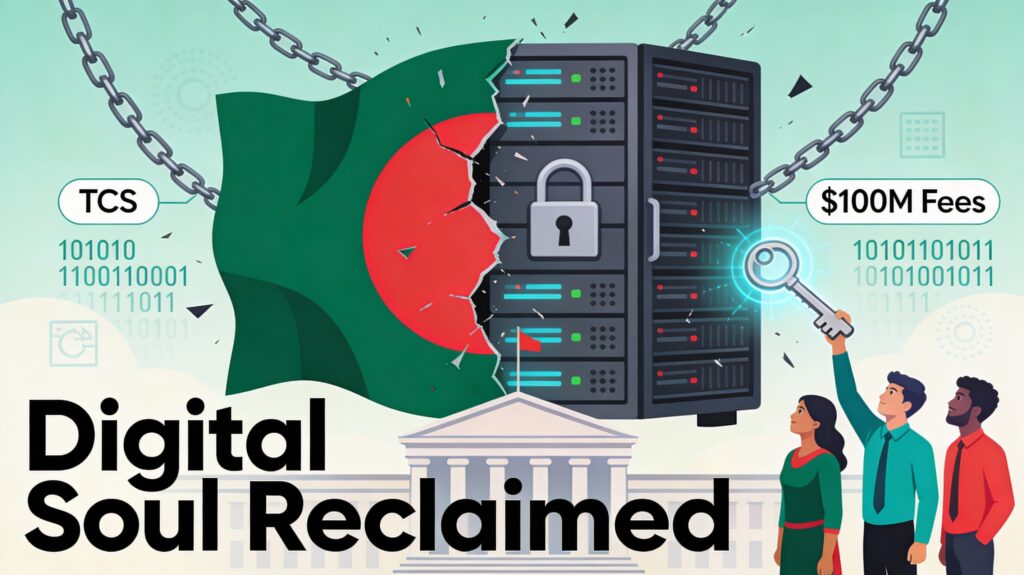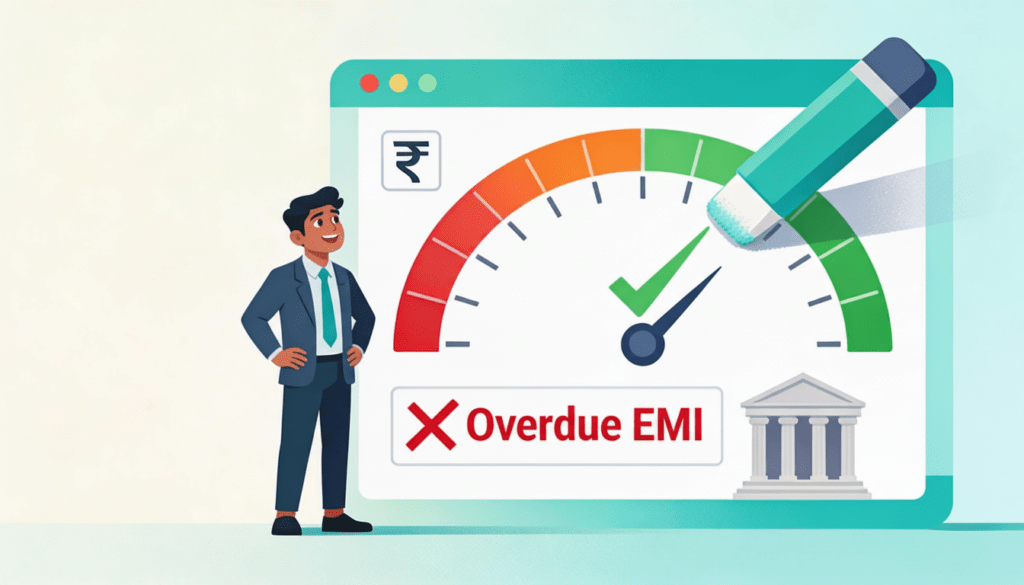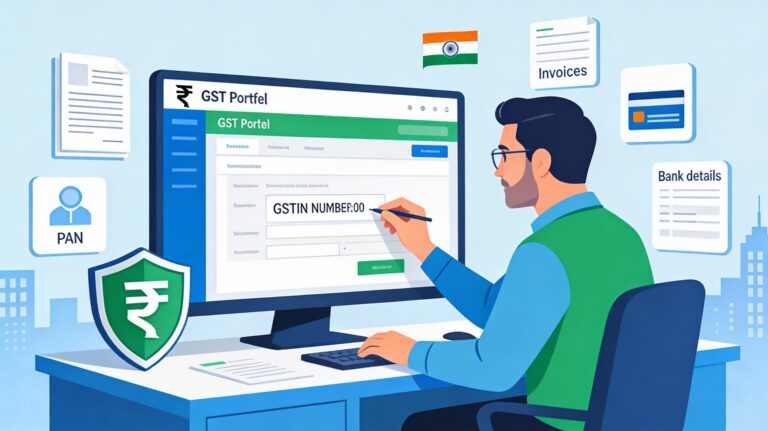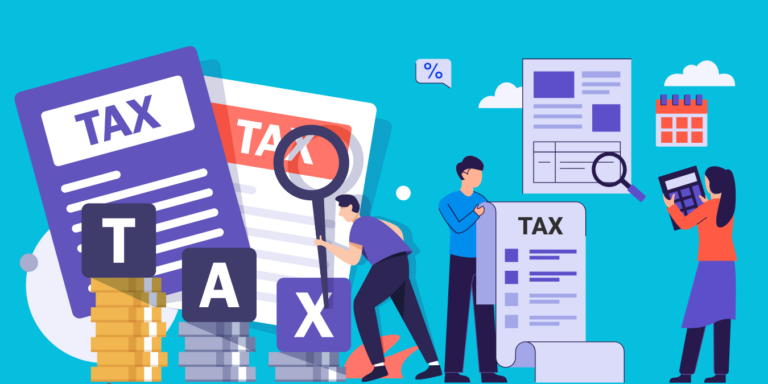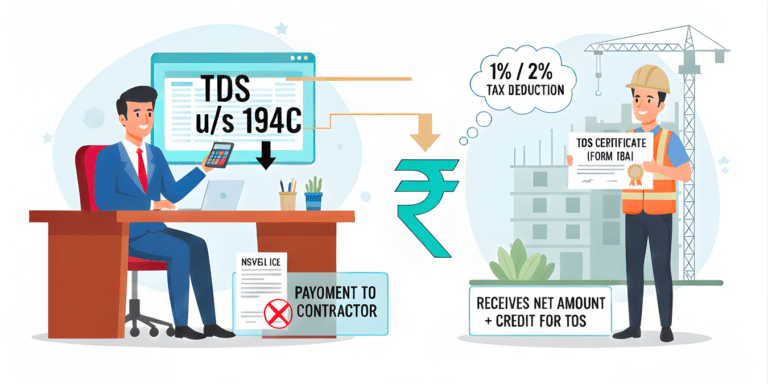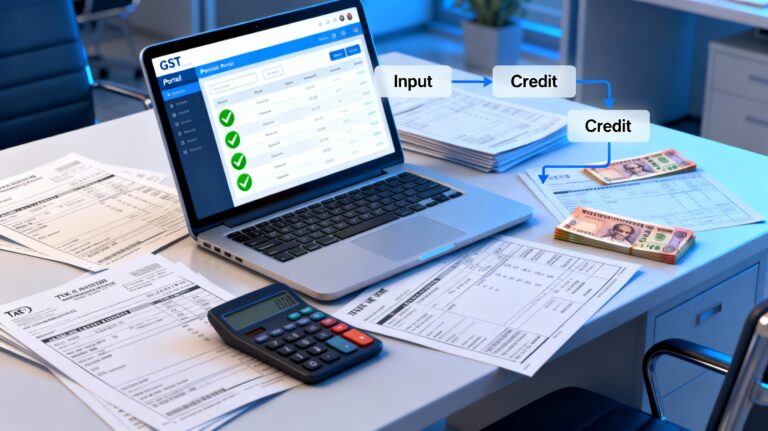
What happens when your income tax refund exceeds ₹50,000? Uncover the suspenseful twists of larger ITR refunds in India for 2025! From enhanced scrutiny to surprise interest gains under Section 244A, this guide reveals secrets to maximize your returns.
You’ve just filed your Income Tax Return (ITR), and the calculations show a refund of ₹75,000. Your heart skips a beat, not with joy, but with worry. Will this large amount trigger additional scrutiny? What procedures await high-value refunds? You’re not alone in this concern—thousands of Indian taxpayers face this exact dilemma every assessment year.
The truth is, when your income tax refund exceeds ₹50,000, you enter a different territory of tax processing that comes with its own set of rules, timelines, and verification procedures. Understanding these nuances could mean the difference between receiving your money promptly or waiting months in uncertainty.
Understanding Income Tax Refunds in India: The Basics
Income tax refunds occur when your prepaid taxes—through TDS, advance tax, or self-assessment—exceed your actual tax liability. For FY 2024-25, millions of Indian taxpayers are claiming refunds due to rising salaries and investments. But what happens when your ITR refund crosses ₹50,000? It’s not just a larger sum; it triggers specific protocols under the Income Tax Act, 1961. Imagine checking the e-filing portal and spotting a refund that could fund a dream vacation. Thrilling, right? Yet, suspense looms: will it arrive quickly, or face delays? According to the Income Tax Department, refunds are processed post e-verification, typically within 4-5 weeks. For smaller amounts, it’s straightforward. But when it exceeds ₹50,000, the plot thickens.
The ₹50,000 Threshold: Why It Matters for ITR Refunds
Why does ₹50,000 matter? This threshold isn’t random—it’s tied to enhanced scrutiny to prevent fraud and ensure compliance. Refunds over ₹50,000 may prompt additional review by the Income Tax Department. This isn’t meant to alarm you; it’s to verify the legitimacy of claims. Recent CBDT data for AY 2024-25 indicates over 7 crore ITRs filed, with average refunds around ₹20,000. However, for those exceeding ₹50,000, processing can extend beyond the usual 15-20 days. Why? The department verifies deductions under sections like 80C, 80D, and HRA. Suspense alert: discrepancies could lead to intimation under Section 143(1), requiring corrections. Ignoring it risks refund delays. The silver lining? Refunds over ₹10,000 qualify for interest under Section 244A at 0.5% per month, potentially boosting your pay out.
What Constitutes a High-Value Refund?
Any income tax refund exceeding ₹50,000 is categorized as a high-value transaction that requires additional verification. This includes:
- Tax Deducted at Source (TDS) refunds above ₹50,000
- Advance tax overpayments exceeding the threshold
- Self-assessment tax refunds above ₹50,000
- Combined refunds from multiple sources totaling more than ₹50,000
Step-by-Step Process for Claiming Income Tax Refunds Over ₹50,000
Claiming an “ITR refund more than 50000” begins with accurate ITR submission. For AY 2025-26, use ITR-1 (Sahaj) for incomes up to ₹50 lakh, or ITR-2 for complex cases. E-filing is mandatory if income exceeds ₹5 lakh or a refund is claimed, per PwC’s 2025 tax summaries.
- File Accurate ITR: Use ITR-1 (Sahaj) for incomes up to ₹50 lakh or ITR-2 for complex cases (AY 2025-26). Ensure e-filing if income exceeds ₹5 lakh or refund is claimed.
- Pre-Validate Bank Account: Link and validate your bank account on the e-filing portal (incometax.gov.in) for direct refund credits.
- Upload Form 26AS and AIS: Match TDS credits with Form 16 and Annual Information Statement to avoid discrepancies.
- E-Verify ITR: Complete verification using Aadhaar OTP, net banking, or DSC within 30 days of filing.
- Monitor Refund Status: Check status on the e-filing portal or NSDL using PAN and AY 2025-26. Expect 4-5 weeks for processing.
- Respond to Queries: If flagged for scrutiny (common for refunds over ₹50,000), submit investment proofs or salary slips promptly via e-proceedings.
- Track Interest: Refunds delayed beyond processing earn 0.5% monthly interest under Section 244A from April 1, 2025.
- Raise Grievance if Delayed: If no refund within 4-5 weeks, file a grievance on the e-filing portal or contact CPC Bengaluru.
Tip: File by September 15, 2025, for FY 2024-25 to maximize interest and minimize delays.
iPhone 17 Air vs. Pro: Which iPhone Will Win India’s Heart with Its OLED Display and A19 Power?
Aditya Birla Sun Life Insurance vs SBI Life eShield vs HDFC Life Click 2 Protect Plus – Which Term Insurance Plan Should You Choose?
What If One 2022 Instagram Reel Just Costed an Indian Techie His $150K Dream Job—and Your Family’s Home Loan?
Rising Gold Costs Push Indians Toward This Surprising New ‘Digital Asset’ — Here’s Why It’s Booming
Additional Scrutiny: The Suspenseful Side of Large Refunds
Here’s where the intrigue deepens. Refunds exceeding ₹50,000 undergo additional scrutiny to validate claims. This involves checking documents like investment proofs or salary slips. HDFC Life’s 2025 guide notes this prevents inflated deductions. Consider Rahul, a salaried professional who claimed a ₹75,000 refund. He faced verification queries, causing delays, but compliance led to a refund with interest. Legal Dalal’s 2023 analysis, still relevant in 2025, confirms pre-validation and potential audits for high-value refunds. Economic Times (May 2025) reports that the extended ITR deadline could yield up to 33.33% more interest for timely filers. Notably, CBDT’s 2022 directive (unchanged in 2025) ensures refunds up to ₹50,000 aren’t withheld during scrutiny under Section 143(3).
Interest on Refunds: A Hidden Benefit for Over ₹50,000 Claims
Delays may build suspense, but there’s a reward: interest. Under Section 244A, refunds over ₹50,000 delayed beyond processing earn 0.5% monthly interest from April 1. For FY 2024-25, the September 15 extension boosts interest for timely filers, per Ujjivan SFB’s 2025 blog. For example, a ₹60,000 refund delayed two months adds ₹600. ClearTax’s August 2025 data shows a 15% rise in average interest payouts due to improved processing. Tip: File early to minimize delays. For refunds over ₹50,000, track status via the e-filing portal or NSDL. If delayed beyond 4-5 weeks, raise a grievance—success rates are high, per Income Tax Department FAQs.
Common Reasons for Delays in Income Tax Refunds Exceeding ₹50,000
Why the wait for your "tax refund more than 50000 India"? Mismatches between Form 16 and 26AS are common culprits. Others include unverified ITRs or incomplete bank details. High-value claims face scrutiny for under-reported income, adding tension.
- Mismatches in Form 16 and 26AS: Discrepancies between TDS reported in Form 16 and Form 26AS lead to scrutiny, delaying refunds.
- Unverified ITR: Failure to e-verify ITR via Aadhaar OTP, net banking, or DSC within 30 days halts processing.
- Incomplete Bank Details: Invalid or unvalidated bank account on the e-filing portal prevents direct credit of refunds.
- Enhanced Scrutiny for High-Value Claims: Refunds over ₹50,000 trigger additional checks for under-reported income or inflated deductions (e.g., 80C, HRA).
- Missing or Incorrect Documents: Lack of supporting proofs (investment receipts, salary slips) delays verification.
- Errors in ITR Filing: Incorrect deductions or mismatched AIS data prompt queries under Section 143(1).
- Systematic Delays: Per Reddit’s r/IndiaTax (2025), refunds over ₹50,000 take 30-45 days versus 13 days for smaller amounts due to rigorous checks.
Tip: Use AI tools on the e-filing portal for error checks and revise ITR under Section 139(5) by December 31, 2025, to resolve issues.
How to Track Your Income Tax Refund Status
Tracking adds suspense but empowers you. Log into incometax.gov.in, enter PAN and AY 2025-26. “Processed with refund due” signals imminent credit. For refunds over ₹50,000, “Under scrutiny” may appear if flagged. NSDL’s 2025 manual confirms 4-5 week timelines. 80% of refunds are issued within 20 days, but larger ones lag at 30-45 days. Stay proactive to avoid surprises.
- Log into e-Filing Portal: Visit incometax.gov.in and sign in with your PAN and password.
- Navigate to Refund Status: Go to "e-File" > "Income Tax Returns" > "View Filed Returns" or directly to "Refund/Refund Re-issue" section.
- Enter Details: Input PAN and select Assessment Year (e.g., AY 2025-26 for FY 2024-25).
- Check Status: View updates like "Processed with refund due" (refund pending credit) or "Under scrutiny" (for refunds over ₹50,000, indicating additional checks).
- Use NSDL Portal: Alternatively, visit tin.tin.nsdl.com to track with PAN and AY. Confirm 4-5 week processing timeline (NSDL, 2025).
- Leverage Apps: Use Tax2win or ClearTax apps for real-time refund alerts.
- Monitor for Delays: Refunds over ₹50,000 may take 30-45 days versus 20 days for smaller amounts (ET Money, 2025).
- Act on Issues: If delayed, raise a grievance on the e-filing portal or contact CPC Bengaluru.
Tip: Regularly check status to stay proactive, especially for large refunds under scrutiny.
Eligibility for Income Tax Refunds
Who qualifies for an "income tax refund over 50000"? Anyone with excess TDS or advance tax. Salaried individuals under the new regime (up to ₹3 lakh exempt) often claim substantial refunds. Seniors benefit from a ₹5 lakh exemption. Tax2win (August 2025) advises filing if income exceeds ₹2.5 lakh (under 60) or ₹3 lakh (seniors). Refunds are mandatory via ITR, even for zero-tax cases. Suspense: Even if exempt, file to claim refunds—miss it, and you lose out.
Maximizing Your Refund: Top Hacks for 2025
Want to boost your ITR refund beyond ₹50,000? Invest in ELSS, NPS (up to ₹50,000 extra under 80CCD(1B)), or health insurance. Budget 2025 FAQs highlight marginal relief for incomes over ₹12 lakh, increasing refunds. Avoid missing 80TTA deductions on savings interest (₹10,000 limit). Strategy: Opt for the old regime if deductions are higher—slabs remain unchanged in 2025:
- Opt for Old Regime: Choose the old tax regime if deductions exceed new regime benefits. Slabs unchanged in 2025 (Budget 2025 FAQs).
- Maximize Deductions: Invest in ELSS, PPF, or NPS (up to ₹1.5 lakh under Section 80C; additional ₹50,000 under 80CCD(1B)). Claim health insurance premiums (Section 80D, up to ₹25,000).
- Claim HRA Fully: Submit rent receipts and landlord PAN (if rent > ₹1 lakh/year) to maximize House Rent Allowance exemptions (SSCO India, 2025).
- Deduct Home Loan Interest: Claim up to ₹2 lakh on home loan interest under Section 24 for self-occupied property.
- Leverage 80TTA: Deduct up to ₹10,000 on savings account interest under Section 80TTA.
- Explore Marginal Relief: For incomes slightly above ₹12 lakh, claim marginal relief to boost refunds (Budget 2025).
- File Early: Submit ITR by September 15, 2025, for FY 2024-25 to minimize delays and maximize interest (0.5% monthly under Section 244A for refunds over ₹10,000).
- Avoid Errors: Use AI tools on the e-filing portal to check for mismatches in Form 26AS and AIS, ensuring accurate claims.
What If Your Refund is Delayed or Denied?
The ultimate suspense: denial. Causes include fraudulent claims or unanswered intimations. For refunds over ₹50,000, e-proceeding appeals are effective. HDFC Bank’s guide recommends contacting CPC Bengaluru for delays. A success story: A ₹1 lakh refund, delayed two months, was credited with interest post-grievance. Canara HSBC (2025) warns: No refunds older than 6 years. Stay vigilant.
Legal Aspects and Compliance for Large Refunds
Under the Income Tax Act, refunds over ₹50,000 require strict compliance. Section 139 mandates timely filing; revisions are allowed until December 31. PwC (May 2025) notes TDS on rent from ₹50,000/month impacts landlords’ refunds. Insight: Use Faceless Assessment for faster query resolution. Ensure compliance to avoid refund holds.
- Mandatory Timely Filing: Under Section 139 of the Income Tax Act, 1961, file ITR by September 15, 2025, for FY 2024-25 (AY 2025-26) to claim refunds. Late filing risks forfeiture.
- Revision Window: Correct errors in ITR under Section 139(5) by December 31, 2025, to avoid refund holds.
- Enhanced Scrutiny: Refunds over ₹50,000 trigger mandatory verification of deductions (e.g., 80C, 80D) to prevent fraud.
- TDS Compliance: New TDS rules (Finance Act, 2025) apply on rent exceeding ₹50,000/month, impacting landlords’ refunds. Ensure accurate TDS reporting in Form 26AS.
- Faceless Assessment: Respond to queries via e-proceedings for faster resolution of scrutiny under Section 143(1) or 143(3) (PwC, May 2025).
- Interest Entitlement: Refunds delayed beyond processing earn 0.5% monthly interest under Section 244A from April 1, 2025, for amounts over ₹10,000.
- No Old Claims: Refunds older than 6 years are not processed, per Canara HSBC (2025).
- Grievance Redressal: If delayed, file grievances on incometax.gov.in or contact CPC Bengaluru for resolution.
Tip: Ensure all proofs (investment receipts, salary slips) are uploaded promptly to comply with scrutiny and expedite refunds over ₹50,000.
Future Trends in Income Tax Refunds for 2026 and Beyond
Looking ahead, AI-driven processing may reduce times for refunds over ₹50,000. Budget 2025 hints at higher exemptions, per CBDT FAQs. Suspense: Will thresholds rise? Stay informed and file accurately to avoid surprises.
- AI-Driven Processing: Advanced AI tools on the e-filing portal may reduce processing times for refunds over ₹50,000 to under 20 days by 2026 (CBDT projections, 2025).
- Higher Exemptions: Budget 2025 hints at increased exemption limits for FY 2025-26, potentially boosting refund amounts (Economic Times, May 2025).
- Enhanced Faceless Assessments: Expanded use of faceless scrutiny under Section 143(3) to streamline verification for large refunds, minimizing delays (PwC, 2025).
- Real-Time TDS Matching: Integration of AIS with real-time TDS data could eliminate mismatches, speeding up refunds (Tax2win, August 2025).
- Increased Interest Rates: Potential hike in Section 244A interest (currently 0.5% monthly) for delayed refunds, enhancing benefits for filers (CBDT FAQs, 2025).
- Digital Refund Platforms: Growth of apps like Tax2win for instant refund tracking and grievance filing, especially for high-value claims.
- Stricter Compliance: Tighter scrutiny for refunds over ₹50,000 to curb fraud, with mandatory digital proof submissions (Legal Dalal, 2025).
Tip: Stay updated on Budget 2026 announcements and file accurately to leverage faster processing and higher exemptions.
Final Thought: Navigating the High-Value Refund Landscape
When your income tax refund exceeds ₹50,000, you're entering a realm of enhanced scrutiny and extended processing times—but this doesn't mean you should be concerned if your claim is legitimate. The key to successfully navigating this process lies in preparation, accuracy, and patience.
The enhanced verification procedures, while potentially frustrating, serve to protect the integrity of India's tax system and ensure that genuine taxpayers receive their due refunds without compromising the exchequer's interests. By understanding these processes and following best practices, you can minimize delays and maximize your chances of a smooth refund experience.
Remember that interest compensation under Section 244A provides some financial relief for extended delays, and the ongoing digital transformation of the Income Tax Department promises more efficient processing in the coming years.
The bottom line: If your refund exceeds ₹50,000, be prepared for a longer wait, maintain meticulous documentation, and consider professional assistance for complex scenarios. Your patience and diligence will ultimately be rewarded with your rightful refund—along with interest compensation for any undue delays.
As India's tax administration continues to evolve, staying informed about these processes and maintaining compliance will ensure that high-value refunds become less of a concern and more of a routine administrative procedure. The future promises faster, more transparent, and more taxpayer-friendly refund processing—but until then, knowledge and preparation remain your best allies in the high-value refund journey.
Disclaimer: The use of any third-party business logos in this content is for informational purposes only and does not imply endorsement or affiliation. All logos are the property of their respective owners, and their use complies with fair use guidelines. For official information, refer to the respective company’s website.





